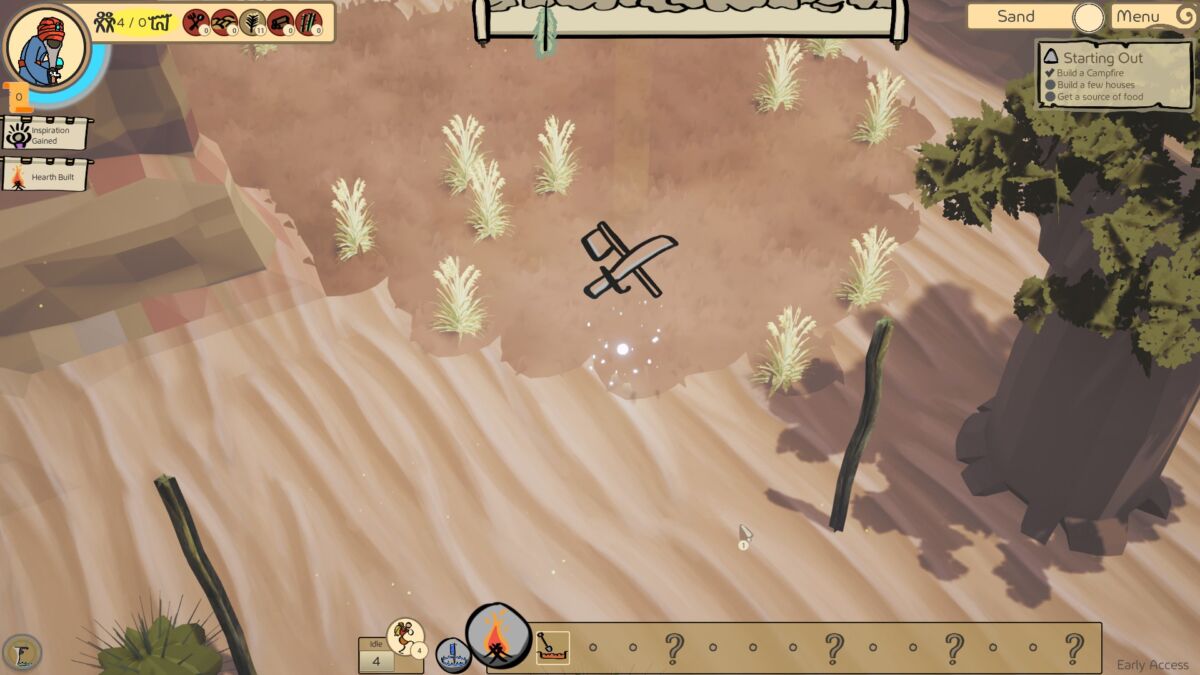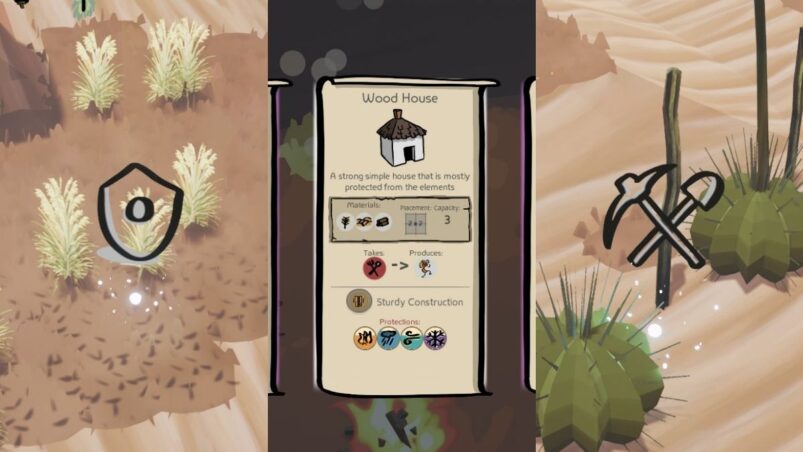Thinkers and their ability to invent new technologies are key to the survival and growth of a successful village in Kainga. To get the village Thinker to work, players will need to send them to points of inspiration where they will find ways to help their settlement evolve.
Here are all the types of inspirations in Kainga:
– Shelter
– Food
– Resources
– Passive
– Protection
– Movement
– Combat
– Festivals
And here’s everything you need to know about inspiration and Thinkers in Kainga.
Shelter

As the first inspiration type, shelter technology doesn’t need to be researched like the rest since as soon as the player places their village hearth, their Thinker will immediately invent shelter. Unlike the rest of the inspiration types, the village will only ever have one type of shelter for the entirety of the mission.
Shelters include homes, lodgings, or any structure that produces new Braves by consuming food and employing an idle worker. Key features of shelters to pay attention to are their capacity and resistance to different types of harsh conditions, like rain, fire, or even snow.
Regardless of the inspiration type, whenever the Thinker invents a new technology, the player will have up to three options from which they can choose from. If none of the tech selections suit the village’s needs, players can either reroll the available options for a small cost in the metagame resources, Karma, or they can reject the current options in favor of a passive improvement.
Except for the shelter type, to invent new technologies, players must lead their Thinker to an inspiration point indicated by a glowing light visible on the horizon. The Thinker will need a short amount of time to come up with the relevant technology.
Food

You might think that since food is key to village population growth, it’d be the first inspiration type instead of shelter. However, over many playthroughs, players will discover how varied food can be as compared to shelter.
Food technology can range from simple rice paddies and crop rows to bakeries and pear farms, each requiring their own resources and locations. It’s most important to consider the terrain around the village and whether or not the settlement may suffer some kind of shock to the food supply. It may be wise to try to get at least two different types of food sources to ensure the population keeps growing, regardless of the weather or any other inclement conditions.
Resources

The resources inspiration leads to technology that helps in the production of basic and advanced resources necessary for construction. Examples of such technology can be the simple clay pit or the fancier lotus pond for the production of fabric. Most of the available terrain types will usually provide enough resources to cover basic needs, but resource technologies can help cover a gap or provide a steady supply of key material.
Passive

As explained above, any time players dislike the technology options they get, they can opt for passive improvements instead. These improvements are typically village wide benefits that affect various elements of the settlement.
Some passives can even give new abilities, such as ropes for taming creatures, or provide baskets to all workers so that they can move around faster. It’s safe to say that in any given playthrough, players won’t need every single technology the Thinker invents and that passive improvements may be more beneficial to the village in the short and long-term.
Protection

Protection technologies cover devices, items, and objects that help bolster the village’s defences against a variety of threats. Here you can find items like wells to help put out fires, cloud windmills to shoo away rain clouds, or even beehives to scare off roaming creatures. Essentially, structures found in this inspiration type don’t necessarily produce anything, but instead ensure the safety and general well-being of the settlement and the villagers within.
Movement

The movement inspiration type gives players structures that allows them to work around and adapt to the terrain. Ladders, bridges, stilts, and platforms can all be found here that gives the village extra options in dealing with heights, cliffs, and bodies of water.
Several creature modifications can also be found here, like the Walker and snail saddles. This inspiration type will be far more useful in more difficult environments, like the Pebbles or Terraces (see environment guide), where the constricting geography and proximity to water will require creative solutions to traverse and utilize.
Combat

In any given mission, players will be forced to interact with a number of NPC villages. Relations may even break down or the mission parameters will require direct hostilities.
The combat inspiration type gives the player various military structures and buildings, such as barracks, ranges, and even beast war rigs to help the settlement arm itself and prepare for battle. This inspiration type is probably the most situational as it might be simpler to simply tribute resources to NPCs and avoid destructive conflict.
Festivals

The most unique inspiration type, players will find the festival inspiration point of interest hovering over the central village hearth. These technologies will often be tied to a mission win condition, so these will be critical to success.
Once unlocked, festivals will usually require some kind of construction project before being activated. After activation, festivals will yield a unique benefit, such as spawn a small bamboo forest, summon a snail from the wild, or even awaken a slumbering Crustacean. Aside from a construction project, a festival will have a resource and population requirement associated with it to be activated.
Unlike most of the previous inspiration types, players are limited to a total of four festival technologies in any given mission. And before these inspirations become available, players will need to invent a number of non-festival technologies first before returning to the village and setting up a new festival type. This means that it’s vital to venture beyond the safety of the village with the Thinker and capitalize on inspiration points that are spread around the map.
Kainga is all about working with difficult conditions and limited resources. The only way for villages to grow and develop successfully is to discover as many technologies as possible to unlock new ways to adapt to the terrain. The specific technology choices are down to the player and the geography they find themselves in.
Kainga is available on PC.
READ NEXT: The Best Strategy Games for Low-End PCs
Some of the coverage you find on Cultured Vultures contains affiliate links, which provide us with small commissions based on purchases made from visiting our site.

